
Understanding the Rich Hues of Dark Brown Eggshells
While attempting to write an article about breeding olive eggers, it became apparent that the discussion would either be excessively long or incomplete without a dedicated exploration of brown egg layers. This necessity arose from the complex genetic basis underpinning eggshell colour, especially the enigmatic brown pigment. Predicting inheritance patterns for brown eggs is challenging due to the limited understanding of the genes involved. Many assume that some brown pigmentation is always inherited, but this is not the case. Observations of progeny, notably from the second (F2) generation onwards, sometimes exhibit eggs with a tan shell colour and occasional brown spots, reflecting the nuanced expression of genes responsible for brown pigmentation.
Contrary to the straightforward inheritance of the blue eggshell colour, attributed to a single dominant gene, the rich brown shades observed in some eggshells emanate from a sophisticated synergy of genetics and biochemistry. This article delves into the intriguing science behind brown eggshell pigmentation and the breeding challenges associated with selecting hens that lay dark brown eggs.
The Central Pigment and Its Partners
Protoporphyrin IX stands as the principal pigment for brown eggshell colouration. This molecule, akin to the haem that gives blood its red hue, is laid onto the eggshell during its formation. However, the final colour can also be influenced by other substances, such as biliverdin, which imparts blue-green shades.
Specific genes govern the synthesis and deposition of these pigments on the eggshell. Some genes directly regulate the production of protoporphyrin IX, while others influence the enzymes essential for its synthesis and placement.
Genes Influencing Brown Eggshell Colour
Several key genes have been identified as influencing the colouration of brown eggshells. These genes regulate various aspects of pigment production, transport, and deposition. However, it is likely that many more genes involved in this process remain undiscovered. Here are a few that have already been identified:
- BCO2 (Beta-carotene oxygenase 2): Plays a role in the deposition of brown pigment.
- SLC45A2 (Solute Carrier Family 45, Member 2): Affects the quantity and distribution of protoporphyrin IX.
- Oocyan (Blue egg gene): Can produce green or olive hues when combined with genes for brown pigment.
- Potential additional genes: Include SLCO1C1, ABCG2, and SLCO1B3 may also be involved.
- Gender-linked genes: Some research suggests gender-linked (also known as sex-linked) genes may influence eggshell colour, but their specifics are less well-understood.
Important Note: Understanding the inheritance patterns of these genes is still an ongoing area of research. We don’t yet fully know which genes are:
- Dominant: A single copy of the gene is enough to express the trait.
- Recessive: Two copies of the gene are required for the trait to be expressed.
- Incomplete Dominance: Neither allele is fully dominant, resulting in a blended phenotype when an individual has two different alleles.
- Co-dominance: Both alleles are fully expressed, leading to the simultaneous display of both phenotypes.
- Polygenic Inheritance: Multiple genes contribute to a single trait, creating a wide range of possible phenotypes.
The science of chicken genetics is ever-evolving, and we may uncover even more genes that play a role in the complex process of eggshell colouration.
The Eggshell Canvas
Primarily composed of calcium carbonate, the eggshell forms as the egg travels through the hen’s oviduct. Brown pigments, such as protoporphyrin IX, are deposited during the later stages of eggshell formation, particularly in the shell gland. This explains why the interior of a dark brown egg remains white when cracked – the pigmentation is primarily on the surface. The intensity and distribution of protoporphyrin IX across the eggshell layers contribute to the deep brown tones characteristic of eggs from certain breeds.
Hypothetical Model to Illustrate the Genetics
To grasp the fundamental principles (while acknowledging that real-world genetics are far more complex), let’s imagine that only two genes influence brown pigmentation. For this exercise, we’ll assume one gene is dominant and the other is recessive. These genes play a key role in determining eggshell colour, which can range from brown to tan.
The Punnett squares below illustrate this concept, envisioning a hypothetical mating between a hen that lays dark brown eggs and one that produces white or tan eggs. Note that the progeny will inherit one copy of each gene (dominant and recessive), potentially resulting in lighter brown eggshell colours.

Keys for the Punnett square above:
‘D‘ represents a fictitious dominant gene for brown eggshells.
‘d‘ represents a fictitious recessive gene for white eggshells.
‘DD‘: Possessing two copies (homozygous) of a fictitious dominant gene for brown eggshells.
‘dd‘: Possessing two copies (homozygous) of a fictitious recessive gene for white eggshells.
‘Dd‘: Possessing one copy of each gene (brown and white) indicates a heterozygous genotype.
F0: Initial parent stock.
F1: First generation cross.
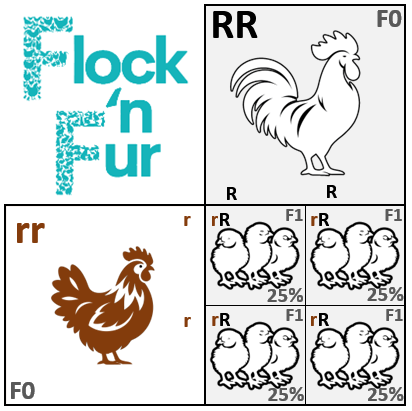
Keys for the Punnett square above:
‘R‘ represents a fictitious dominant gene for white eggshells.
‘r‘ represents a fictitious recessive gene for brown eggshells.
‘RR‘: Possessing two copies (homozygous) of a fictitious dominant gene for white eggshells.
‘rr‘: Possessing two copies (homozygous) of a fictitious recessive gene for brown eggshells.
‘rR‘: Possessing one copy of each gene (brown and white) indicates a heterozygous genotype.
F0: Initial parent stock.
F1: First generation cross.
Crossing the F1 Generation: Hypothetical Illustration
Remember, this is a simplified model. In reality, multiple genes likely influence brown eggshell colour.
When crossing the F1 generation, here’s how the genes might distribute:
- Fictitious Dominant Gene:
- 25% of offspring won’t inherit the dominant gene.
- 50% will inherit one copy.
- 25% will inherit two copies.
- Fictitious Recessive Gene:
- 25% of offspring won’t inherit the recessive gene.
- 50% will inherit one copy.
- 25% will inherit two copies.
Eggshell Colour Outcomes
- Offspring with one or two copies of the dominant gene will lay eggs with brown shells.
- Only offspring with two copies of the recessive gene will lay brown eggs.
- The darkest eggs will come from hens with one or two copies of the dominant gene AND two copies of the recessive gene.
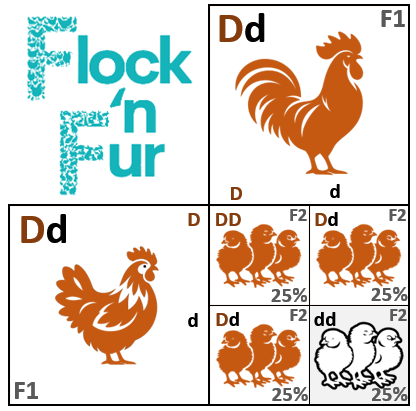
25% of the offspring possessing no copies of the fictitious dominant gene for brown eggshells.
50% of the offspring possessing one copy of the fictitious dominant gene for brown eggshells
Keys for the Punnett square above:
‘D‘ represents a fictitious dominant gene for brown eggshells.
‘d‘ represents a fictitious recessive gene for white eggshells.
‘DD‘: Possessing two copies (homozygous) of a fictitious dominant gene for brown eggshells.
‘dd‘: Possessing two copies (homozygous) of a fictitious recessive gene for white eggshells.
‘Dd‘: Possessing one copy of each gene (brown and white) indicates a heterozygous genotype.
F1: First generation cross.
F2: Second generation cross.

25% of the offspring possessing no copies of the fictitious recessive gene for brown eggshells.
50% of the offspring possessing one copy of the fictitious recessive gene for brown eggshells.
Keys for the Punnett square above:
‘R‘ represents a fictitious dominant gene for white eggshells.
‘r‘ represents a fictitious recessive gene for brown eggshells.
‘RR‘: Possessing two copies (homozygous) of a fictitious dominant gene for white eggshells.
‘rr‘: Possessing two copies (homozygous) of a fictitious recessive gene for brown eggshells.
‘rR‘: Possessing one copy of each gene (brown and white) indicates a heterozygous genotype.
F1: First generation cross.
F2: Second generation cross.
As we are breeding for two traits, further calculations are needed to determine the probability of offspring inheriting a specific combination of genes. To do this, you multiply the probability of inheriting one gene by the probability of inheriting the other. This method relies on the principle of independent assortment in genetics. When genes for different traits are located on separate chromosomes, they are inherited independently of each other.

These genes create a variety of brown hues. The offspring that inherit two copies of both the dominant and recessive genes (6% probability, calculated by multiplying the 25% chance for each) produce the darkest eggshells. Even with just two genes, we can start to see the potential for diverse shell colours. However, in reality, numerous unknown genes with complex inheritance patterns are involved, making precise colour predictions significantly more challenging. The image below illustrates a probable distribution when combining the two sets of genes – note that rounding has been applied for simplicity.
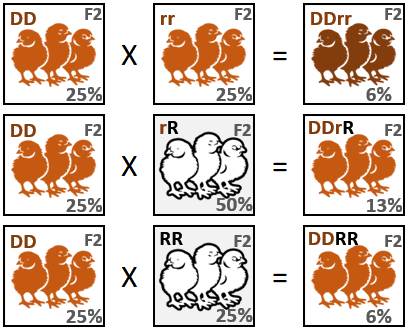
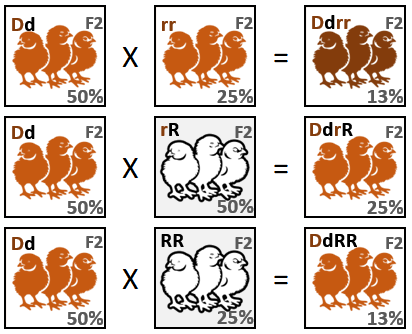
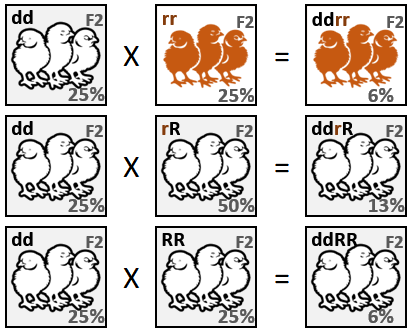
19% dark brown eggshells.
62% brown eggshells.
19% white eggshells.
From the above calculations, only 19% (6% + 13%) of offspring will lay the darkest brown eggs, and 19% will lay white or tan. The rest will lay eggs with varying shades of brown in between.
While crossing your first-generation (F1) chickens might seem like a way to increase dark egg layers, it’s not the most efficient strategy. Approximately 19% of their offspring will lay dark eggs, but only 6% of those will reliably produce hens with the same trait. Unfortunately, we don’t have easy ways to test for the specific genes responsible for egg colour, making this more of a theoretical exercise than a practical breeding approach
Back-Crossing the F1 Generation: Hypothetical Illustration
To improve your chances of getting dark egg layers, consider back-crossing your F1 generation with your original dark layer chickens (F0), such as Marans. This involves mating your F1 chickens back to the F0 generation. You can pair either an F1 hen with an F0 rooster or an F0 hen with an F1 rooster. Back-crossing significantly increases your odds of producing offspring that lay dark brown eggs.

50% of the offspring possessing one copy of the fictitious dominant gene for brown eggshells
Keys for the Punnett square above:
‘D‘ represents a fictitious dominant gene for brown eggshells.
‘d‘ represents a fictitious recessive gene for white eggshells.
‘DD‘: Possessing two copies (homozygous) of a fictitious dominant gene for brown eggshells.
‘dd‘: Possessing two copies (homozygous) of a fictitious recessive gene for white eggshells.
‘Dd‘: Possessing one copy of each gene (brown and white) indicates a heterozygous genotype.
F0: Initial parent stock.
F1: First generation cross.
F2BC: Second generation back cross.

50% of the offspring possessing one copy of the fictitious recessive gene for brown eggshells.
Keys for the Punnett square above:
‘R‘ represents a fictitious dominant gene for white eggshells.
‘r‘ represents a fictitious recessive gene for brown eggshells.
‘RR‘: Possessing two copies (homozygous) of a fictitious dominant gene for white eggshells.
‘rr‘: Possessing two copies (homozygous) of a fictitious recessive gene for brown eggshells.
‘rR‘: Possessing one copy of each gene (brown and white) indicates a heterozygous genotype.
F0: Initial parent stock.
F1: First generation cross.
F2BC: Second generation back cross.
Dominant Gene: 100% of the offspring would lay dark eggs. 50% would inherit two copies of the gene, and the other 50% would inherit one copy – both resulting in dark eggshells.
Recessive Gene: 50% of offspring would inherit two copies and lay dark eggs. The other 50% would inherit only one copy, not expressing the trait, and thus laying white or possibly tan eggs.

When considering both the hypothetical dominant and recessive genes in your breeding strategy, you could expect 50% of the offspring to lay dark brown eggs. Of these, 25% would carry two copies of each gene – ideal for further breeding to produce dark-egg layers. The remaining offspring, although not laying the darkest eggs, would still produce brown eggs, as they all carry at least one copy of the dominant gene. This is unlike the case of crossing the F1 generation with one another, where 19% laid white or tan eggs.
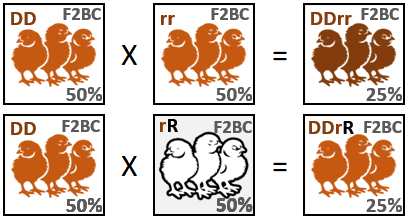
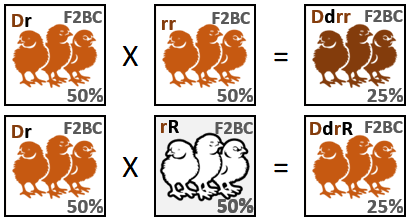
50% dark brown eggshells.
50% brown eggshells.
Since we cannot definitively test for specific genes due to gaps in our knowledge, a more practical approach is to select breeders based on the darkness of the eggs they lay. This strategy involves back-crossing chickens until you achieve the desired egg colour depth, always selecting the darkest-egg-laying hens for further breeding. Over time, this process should gradually increase the prevalence of dark egg layers in your flock.
Challenges for Breeders
Breeders striving for dark eggshells primarily select individuals based on the visible trait. This method is complicated by a few factors: incomplete knowledge of the genes involved (especially from the rooster’s side), the bird’s overall genetic background, and uncertainties in how those genes interact. Despite these challenges, experienced breeders can improve their success through meticulous selection, lineage tracking, and a greater understanding of the complex genetic picture influencing eggshell colour.
Important Considerations
Not all dark brown egg layers are equal. Due to our incomplete understanding of the genetics and the variation seen even within purebred lines, some hens carry different gene combinations than others. Therefore, starting with the darkest brown eggs you can find is crucial. No amount of backcrossing or selective breeding will introduce genes that aren’t present in your original flock. Remember, a vast array of genes influences dark brown egg colour – the darkest shades are only achievable if your flock has all the necessary genes, and you consistently breed your darkest layers together.
Beyond Genetics
This article has focused on genetic factors influencing eggshell colour, but other factors can also affect the shade of brown. A young hen’s first few eggs are typically her darkest. As she ages and lays more frequently, her eggs tend to lighten. This is similar to how a printer running low on ink produces faded pages. After a rest period, like moulting or broodiness, her eggs will darken again. This highlights why it’s best to assess a hen’s genetic potential for egg colour early in her laying cycle. While some hens’ eggs pale significantly over time, identifying and breeding hens that consistently lay darker eggs is crucial for producing offspring that maintain dark brown eggshells.
In Summary: The Cheat Sheet

